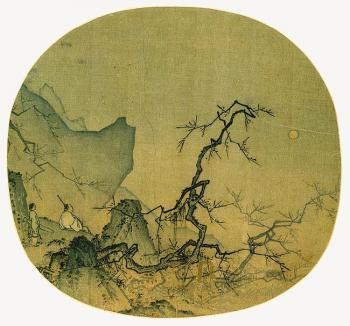Renowned painter Hung Bin Hong (1865 - 1955) categorized painting this way: scenes from the markets and streets, mountains and lakes, and the paintings by the Shi Da Fu. According to his understanding, a painter aspiring to master the requirements of this highest art form must be cognizant of a high level of the teachings of Confucius. He must possess broad-ranging knowledge and have mastered the techniques of painting to a high degree. Furthermore, he must have a general ability to bring a nation towards peace and prosperity. Such an individual must personally have cultivated well and have acquired a fine individual, moral yardstick.
Li Ku-Chan (1898 - 1983) is an equally well-known painter who learned traditional Chinese painting from Qi Bai Shi. Li often said, “Man must first of all have noble characteristics, then he will possess the necessary nobility to paint well. A human being exhibiting negative characteristics is unable to paint a single righteous brush stroke.”
Li Ku-Chan had to endure ten days of incarceration during the Cultural Revolution (1966 - 1976). His own students then tormented and almost beat him to death for refusing to paint according to the prevailing political trend at the time. To extricate himself from this dilemma, some pleaded with him to paint agricultural scenes, such as a huge crop [being harvested]. He countered this suggestion with an ironic smile and said, “Yes, I will paint such scenes and title them ‘Selling one’s soul cheaply,’ or ‘huge crop of bodies.’” (Editorial comment: 40 million Chinese died from starvation during the Cultural Revolution, due to faulty agricultural planning and mismanagement). The regime officials compelled the painter to do public self-criticism sessions where the rulers attempted to make him denounce his teacher Qi Bai Shi. Li Kun-Chan refused, was seized and assigned to work in the fields. But even there he continued to practice qi gong. The following adage from that era is attributed to him, “Those who destroy the homeland and torment the populace can be assured the revenge of the Heavens. I will persist until that day.”
Tony Dai’s background:
He grew up in China and now lives in Australia. Tony is a stock market trader, but his passion is art.
He is an art collector and chairman of the Australian Chinese Traditional Culture and Arts Association. Together with his mother Meiling Dai, Tony is a fifth-generation owner of one of the most extensive collections of 19th and 20th Century traditional Chinese paintings, containing works by more than 40 masters from that era. Besides works by Qi and Li, the collection contains pieces by an emperor and an empress. The collection is particularly unique, because not many such works survived the barbaric years of the Cultural Revolution.
Tony trained in calligraphy and Chinese painting from early childhood and won a national Chinese calligraphy competition at the age of eight. A relative, a mandarin at the last emperor’s court, laid the foundation for the present collection. It has been exhibited since 2003, in Australia and Southeast Asia, as well as in several cities in the USA and Canada. The works document a thorough representation of traditional Chinese painting, quite different from Western traditions. It is the aim of traditional Chinese painting to portray the artist’s impressions and that of his medium in an abstract manner. Ink painting is an expression of high artistic form and meditative concentration, which does not leave room for corrections, once a painting is finished. Each brush stroke is an expression of the artist’s personality and a reflection of his momentary perceptions.





